Holocene climatic change reconstructed from trace elements of an aeolian deposit in the southeastern Mu Us Desert,northern China
Bing Liu ,HeLing Jin ,LiangYing Sun ,WenPing Xue,ZhenYu Liu
1. Key Laboratory of Desert and Desertification, Northwest Institute of Eco-Environment and Resources, Chinese Academy of Sciences,Lanzhou,Gansu 730000,China
2.MOE Key Laboratory of Western China Environmental System,Lanzhou University,Lanzhou,Gansu 730000,China
ABSTRACT In semi-arid and arid desert regions of northern China, aeolian deposits document the framework variation of an Asian monsoon during the late Quaternary.However,there is still a lack of detailed data pertaining to Holocene Asian monsoonal variation especial in the modern Asian summer monsoonal boundary belt.In this study,we reconstructed Holocene millennial-scale climatic changes in the Mu Us Desert, northern China, through systematic analysis of the variation of trace elements (324 samples) in different lithological units of the palaeosol-aeolian sand deposit, in combination with 14C and OSL chronology. Statistical results, correlation and clustering analysis indicate that the high content of 11 trace elements(V,Y,Cr,Nb,P,Mn,Cu,Zr,As,Ni and Rb,represented by P)and lower Sr content corresponding to periods of palaeosol development,marked increase of vegetation,weathering degree,and enhanced Asian summer monsoonal strength.In contrast, their opposed variation are coincident with accumulated aeolian sand layers, implying weaker summer monsoons and less geochemical weathering and degraded vegetation.These associations can be considered as signaling regional humid and dry changes of the Holocene environment.Accordingly, relatively arid conditions dominated the region before 7.2 ka,and there was an optimal humid climate in 7.2-4.6 ka.Afterwards,the climate became obviously dry,accompanied with several cycles of relatively wet and dry, such as relatively wet intervals around 4.1-3.7 ka, 3.5-3.3 ka and 2.5 ka. In addition,six millennial-scale dry events were recorded,and these events were consistent with weaker Asian summer monsoonal intervals in low latitudes, declined palaeosol development and precipitation in middle latitudes, as well as increased winter monsoon and periodic ice-rafting events in high latitudes of the Northern Hemisphere, within limits of accuracy of existing dating ages. This possibly suggests a noteworthy synchronism between millennial-scale climatic changes in this region and on a global scale.
Keywords:Holocene climatic change;Mu Us Desert;Aeolian deposit;trace element;synchronism
1 Introduction
Since the 1990s, evidence of Holocene millennialscale climatic oscillation was discovered in deep-sea deposits in the North Atlantic (Bianchi and McCave,1999; Bond et al., 2001), Indian (Overpeck et al.,1996; Gupta et al., 2003), and western Pacific oceans(Linsley,1996)and in ice cores (O'Brien et al.,1995).Numerous geological evidence in monsoonal China,such as stalagmites (Wang et al., 2005; Hu et al.,2008), peat (Zhou et al., 2002a; Hong et al., 2003;Liu et al., 2014a), lake deposits (Chen et al., 2001;Xiao et al., 2004), loess (Yu et al., 2006), and aeolian deposits(Guo et al.,2000;Zhou et al.,2009;Jin et al.,2010; Liu et al., 2014b) have demonstrated that Holocene climatic changes had obvious instability and periodicity.In northern China,deserts and dune fields have also provided crucial archives for understanding past climatic changes and responses to global change (Gao et al.,1993;Jin et al.,2001;Lu et al.,2005,2013;Sun et al., 2006; Mason et al., 2009; Ma et al., 2011; Jia et al.,2015).Previous research has indicated that periodic climatic changes,especially millennial-scale dry events in the deserts of northern China, are closely related with cold intervals in high latitudes of the Northern Hemisphere since the late Quaternary (Zhou et al.,2009; Du et al., 2012; Niu et al., 2015; Wen et al.,2016). Nevertheless, there is still scarce research on whether there were similar characteristics in the Holocene in the deserts of northern China.
The Mu Us Desert lies at the northern margin of the modern Asian summer monsoon (Figure 1a), and is an important component of the farming and pastoral zone in northern China. Given its fragile natural environment and hydrothermal sensitivity, it is a focus area for the study of climatic change and feedback mechanisms. In this region, recent studies of Holocene climatic and environmental change have mainly concentrated on aeolian sand-palaeosol sequences(Chen et al., 1993, 1994; Gao et al., 1993; Lu et al.,2005; Sun et al., 2006; Li et al., 2007; Mason et al.,2009; Ma et al., 2011; Jia et al., 2015), peat deposits(Zhou et al., 2002b; Li et al., 2003), and fluvial-lake deposits (Guo et al., 2007; Liu and Lai, 2012; Sun and Feng, 2013; Zhao et al., 2016). Results from aeolian sand-palaeosols and lake deposits indicated a relatively dry early Holocene, an optimal humid mid-Holocene, and a gradually dry late Holocene, whereas peat research indicated relatively warm and arid climatic conditions in the Mid-Holocene. On the Holocene sub-orbital scale, the lacustrine-palaeosol-aeolian sand sediments from the Salawusu River (Niu et al., 2008; Lu et al., 2010) demonstrated that periodically cold stages punctuated the whole pattern of regional climatic change,however,related evidence still need to be examined and validated by other geological materials due to the complex sedimentary environment of the material.
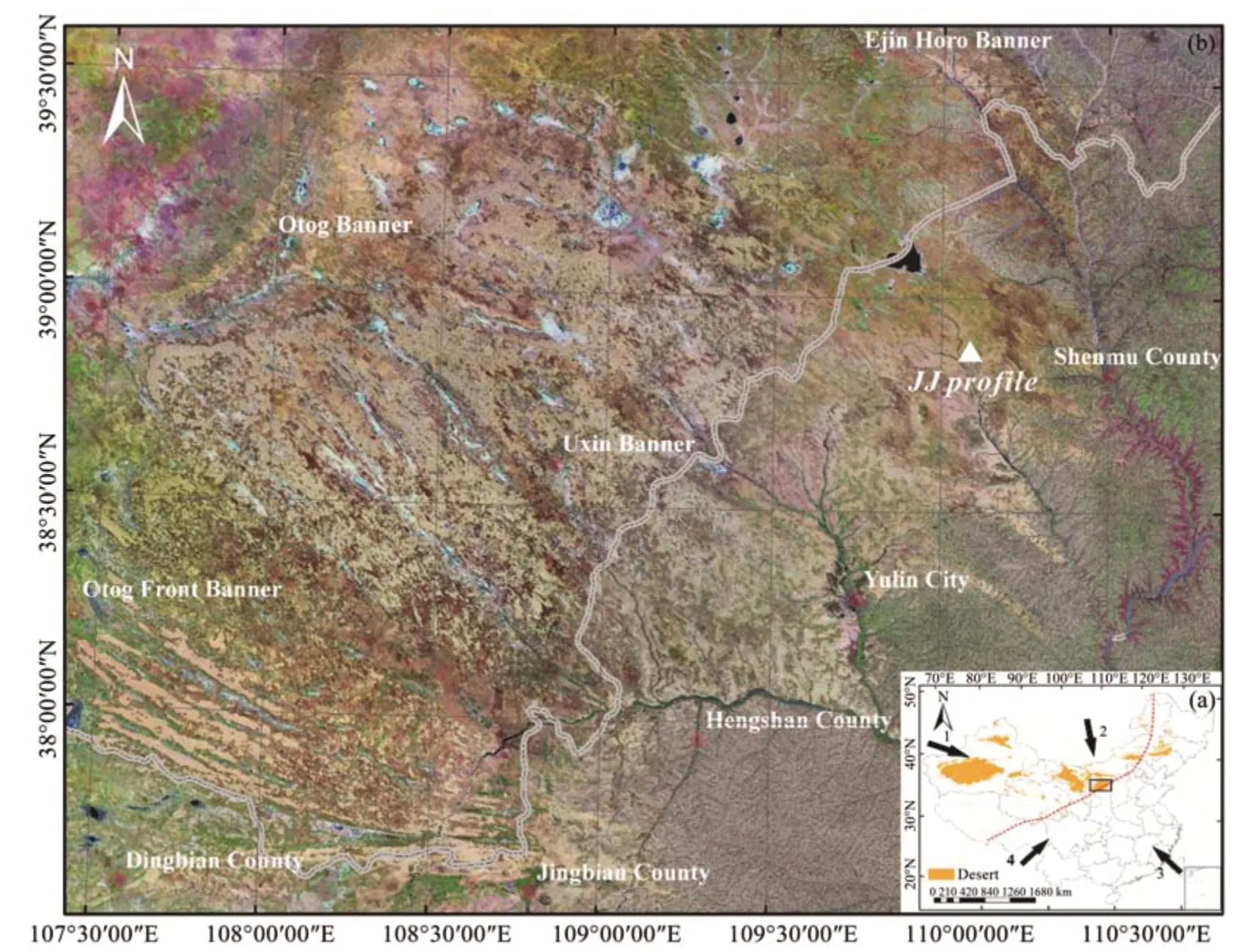
Figure 1 Location of the study area.(a)The Mu Us Desert(black);dashed line shows the present limit of the Asian summer monsoon influence.Arrows denote:1,westerlies;2,winter monsoon;3,southwest monsoon;4,southeast monsoon.(b)Remote-sensing image of the Mu Us Desert and the JJ profile(white triangle)
Therefore, in this study we chose aeolian-palaeosol deposits in the southeastern Mu Us Desert in order to examine the processes of Holocene millennial-scale climatic change,and the consistencies and differences between this region and global climatic change, through systematic analysis of the variation of trace elements in the deposits,along with14C and OSL chronology.
2 Regional setting
The Mu Us Desert(37°27′N-39°22′N,107°20′E-111°30′E) has an area of 4.22×104km2and an altitude between 1,100 and 1,500 m a.s.l.. The ground surface is dominated by semi-fixed, fixed, and mobile dunes, of which the semi-fixed and fixed dunes consist of the Beam honeycomb dune and several nabkha dunes,and the mobile dunes are composed of crescent dunes and chains of sand dunes (Figure 1b). The region has a typical arid and semi-arid continental monsoonal climate, with an annual average temperature of 6.0-9.0 °C and precipitation of 400-200 mm. The 70% of the rainfall occurs in the summer and northwestern winds dominate this area in the winter and spring. The modern vegetation is temperate steppe and desert steppe type, mainly Artemisia ordosica,
Caragana microphylla, and xerophytic Gramineae spp. Additionally, Salix mongolica, S. psammophila,Achnatherum splendens, and Kalidium foliatum also grow in interdunal depressions and bottom lands. The zonal soils are comprised of brown, light chestnut,and dark loessial soils from the west to east in this region, and the azonal soils are saline-alkali soil, meadow soil,and sandy soil(Wang,2011).
3 Material and methods
3.1 Lithology
The JJ (Jinjie) profile (38°44.594′N, 110°10.044′E),at an altitude of 1,159 m a.s.l., is located in the Jinjie Economic Development Zone in Shenmu County,southeastern Mu Us Desert,China.Fixed dunes dominate the ground surface and the vegetation coverage is approximately 70%-80%, mainly Artemisiaordosica and Salix psammophila.The thickness of the profile is 740 cm, which can be divided into five aeolian sand layers,three palaeosols,one weakly developed palaeosol, and one sod horizon. The aeolian sands are turbid yellow orange, light grey, and grayish yellow medium and fine sand, medium sorted to fine, loose to slight compacted, non-stratified and aeolian progradation laminae.The palaeosols are grey and yellowish-brown,light grey, and taupe brown silty fine sand, medium sorted to weak, slightly compacted to hard, non-stratified. The weakly developed palaeosol is composed of grey and yellowish-brown and taupe brown medium and fine sand, slightly compacted to compacted, nonstratified.The sod horizon is grey and yellowish-brown medium and fine sand, slightly loose to compacted,with obvious horizontal bedding(Figure 2a).
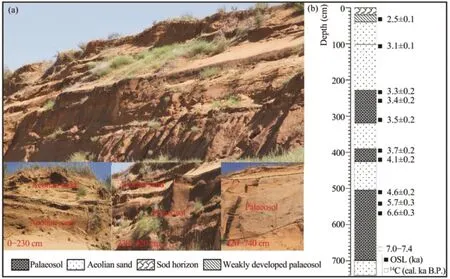
Figure 2 Lithostratigraphic variation(a)and OSL and conventional 14C dating(b)of the JJ profile
3.2 Methods
Three hundred and twenty four samples were taken from the JJ profile at 2 and 4 cm intervals from the top to bottom, and they were tested for trace elements by the Key Laboratory of Desert and Desertification(Cold and Arid Regions Environmental and Engineering Research Institute, Chinese Academy of Sciences). The procedures were as follows: First we dried and ground the samples, and sifted them through a 200-mesh screen. Then 4-g powdered samples were placed into the mold with boric acid for the edge and bottom and were pressed into round discs (32-mm diameter)at 30-ton pressure and 105°C.The discs were measured with the spectrometer (type:Axios), using a super-long, sharp-pointed ceramic X-ray light tube(4-kW power) and a pipe flow of 160 mA. The estimated error was less than 5%. The test object is composed of 13 trace elements, e.g., P,V, Cr, Mn, Ni, Cu,As, Rb, Sr, Y, Zr, Nb and Ba.Additionally, grain size analysis was performed at the Key Laboratory of Western China Environmental System (Ministry of Education). The experimental procedure was similar to that of Liu et al. (2014a) and the estimated error was within 0.3%. The OM (Organic Matter) content was determined by loss on ignition (LOI) when the samples were heated at 550°C for 2 h.
3.3 Chronology
OSL(Optically Stimulated Luminescence) and14C samples were collected from the JJ profile in field reconnaissance. OSL samples were obtained by hammering aluminum tubes into the freshly cleaned vertical section, and sealing them with plastic tape to avoid light exposure and moisture loss. The samples were then analyzed by the Institute of Hydrogeology and Environment Geology (Chinese Academy of the Geological Sciences) using an automated Daybreak 2200 reader. The detailed sample preparation and experimental procedure were reported by Zhao et al.(2010). Conventional14C sample was analyzed by a low-background liquid scintillation counter at the Key Laboratory of Western China Environmental System(Ministry of Education), Lanzhou University, and the dating material was organic matter (OM). Radiocarbon ages were adjusted to use a 5,568-year half-life of radiocarbon, using the INTCAL 04 Northern Hemisphere non-sea land correction mode. OSL and14C results are presented in Figure 2b (Liu et al., 2014a).Furthermore, we also calculated the detailed age of bottom palaeosol(504-700 cm)according to the sedimentation rate.
4 Results
4.1 Characteristics of trace elements in the profile
Based on statistical analysis of trace element contents and variations of their curve in the JJ profile, we discovered that there are two main characteristics (Table 1 and Figure 3):
(1) Contents of trace elements are the prominent differences in the profile:the contents of P,Sr,and Ba are highest, ranging from 219.66-410.82, 293.81-373.07, and 796.47-980.90 ppm, respectively, with means of 286.18, 331.88, and 911.13 ppm. The contents of Mn, Rb, and Zr are secondary, fluctuating from 87.64-299.43, 76.55-86.66, and 61.44-188.20 ppm, respectively, with averages of 181.92, 80.07,and 111.56 ppm.The contents of the others(V,Cr,Ni,Cu,As,Y,and Nb)are all less than 40 ppm.
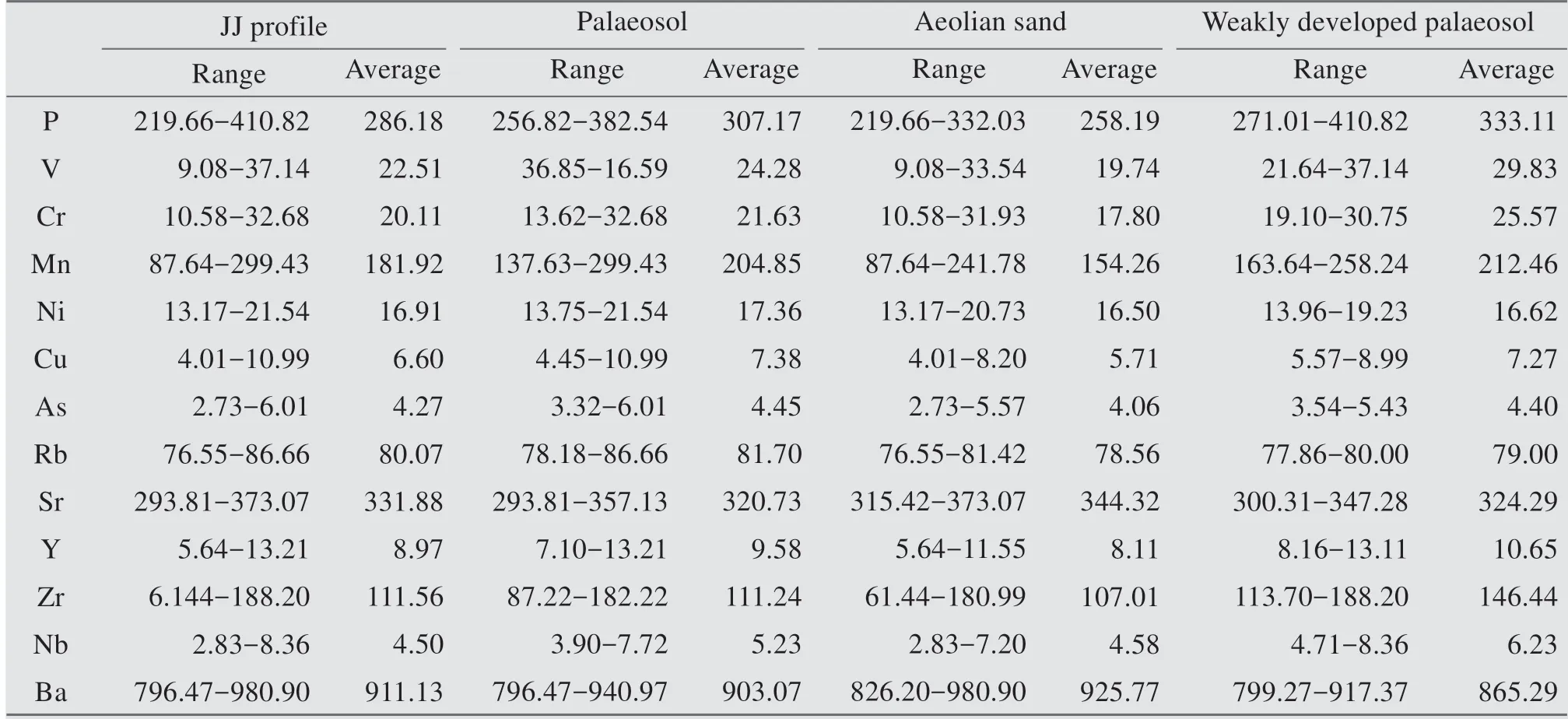
Table 1 Statistical analysis of trace element contents in the different lithologies of the JJ profile
(2) Variation of trace elements had an obvious regularity in the different lithologies of the JJ profile.Most of the trace elements,such as P,V,Cr,Mn,Ni, Cu, As, Rb, Y, Zr, and Nb, presented high contents in palaeosol and weakly developed palaeosol,while they had lower values in the aeolian sand layer. Conversely, Sr and Ba contents were higher in the aeolian sand (averaging 344.32 ppm and 925.77 ppm, respectively), and were lower in palaeosol(means of 320.73 ppm and 903.07 ppm) and weakly developed palaeosol (means of 324.29 ppm and 865.29 ppm).
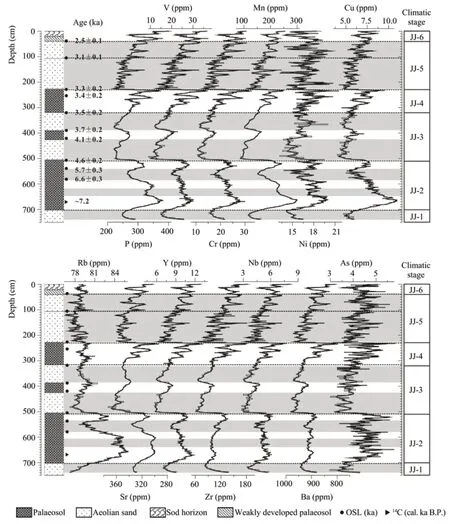
Figure 3 Variation of trace elements and indicated climate change in the JJ profile,southeastern Mu Us Desert
4.2 Climatic significances of the trace elements
Variations of trace elements in the aeolian deposits were closely related to their geochemical behavior,while also influenced by climatic and environmental conditions, such as, the materials source, weathering degree, and surface vegetation. Therefore, we firstly ascertain the similarities and differences of the aforementioned elements behavior, using the correlation analysis method. Table 2 indicates that most of correlation coefficients of the 11 elements (P, V, Cr, Mn,Ni, Cu, As, Rb, Y, Zr and Nb) reached >0.5, except for Sr and Ba. That is, 11 elements presented the coherence variation in the profile, reflecting an identical and similar geochemical behavior. Conversely, Sr and Ba had wide differences compared to the foregoing elements, which indicate that there are discrepant geochemical properties.We also performed a cluster analysis based on the methods of the closest distance.Cluster analysis (Figure 4) indicated that Sr and Ba can be used as one category and other measured elements can be categorized as the other. These results are very coincident with the correlation analysis among various geochemical elements. Furthermore, we analyzed climatic and environmental factors for the trace element content. In this region, Liu et al. (2016) found that there is a similar material source between modern and Holocene aeolian sand, implying the material source of aeolian deposits was not the main cause for the differences of trace elements content in different lithological units. In other words, trace elements were probably influenced by different geochemical behaviors of the elements and related environmental conditions, such as, grain size, weathering degree and surface vegetation.We therefore analyzed the relationships between the aforementioned elements and≥63 μm, <4 μm, and organic matter (OM) contents,and the CIA(the chemical index of alteration).

where the chemical oxide values are molecular formulae and the CaO* is the amount of CaO incorporated in the silicate fraction (Nesbitt and Young, 1982;McLennan,1993).

Table 2 Correlation coefficients of trace elements in the JJ profile
Figures 5a-5c indicates that the P content increased along with the increased weathering degree and vegetation and <4 μm (clay) content, while it sharply declined with increased ≥63 μm (sand) content (Figure 5d). In the semi-arid and arid monsoon's boundary zone of northern China, the P content of aeolian deposits was mainly determined by biological accumulation and its content is positively correlated with the total organic carbon (TOC) content (Liu et al., 2012). The P content increased under a warm and humid condition, along with increased biological and chemical weathering and clay content, when the summer monsoonal strength increased;conversely,the decreased P content is accordant with the declined weathering degree, vegetation cover and the clay content (Gao et al., 1993), while the ≥63 μm content became high. That is, P can be regarded as an indicator for Asian summer monsoonal strength and related environmental conditions.
The trace element Sr is usually found in silicate and carbonate minerals,such as potassium feldspar,anorthosite, hornblende, and mica. In the process of weathering and pedogenesis, Sr is released from these minerals and is removed by surface and ground water in the dissociative form, and its quantity becomes lower because of the relatively small ionic radius of Sr2+(Chen et al., 1999). In this study, we found that there was lower Sr content in palaeosols and weakly developed palaeosols, while it was high in aeolian sand. Sr had a strong negative correlation with CIA, OM, and clay content(Figures 5e-5g),while positively correlated with the ≥63 μm content (Figure 5h). This suggests that Sr was intensively leached and its content became lower in the palaeosol as a result of enhanced weathering degree and increased vegetation with stronger summer monsoons. Conversely, it was weakly leached (or even not leached)and maintained a high content in aeolian sand, accompanying lessened vegetation, weathering,and summer monsoonal strength.
Ba, a very active element, exists in K-containing minerals in an isomorphic form such as potassium feldspar and mica. It is readily absorbed by clay minerals(K-containing) during geochemical weathering because of its larger ionic radius, resulting in higher content in sediments. Thus, its higher content reflects relatively humid conditions, whereas it decreases in dry environments (Dong et al., 1993). Statistical analysis of 324 samples taken from the JJ profile show a lower Ba content in palaeosols, which implies relatively stronger weathering in the geological period, whereas it had a remarkably higher content in aeolian sand layers(Table 1 and Figure 3). Moreover, the correlation coefficients between Ba and other parameters (CIA, OM and <4 μm content)are-0.297,-0.559 and-0.445,respectively(Figures 5i-5j).This was very discrepant from previous results(Dong et al.,1993)showing that Ba content is correspondingly increased with enhanced summer monsoons and weathering degree in deserts of northern China. Adversely, Ba was clearly positively correlated with ≥63-μm content (Figure 5l), which is similar to that variation of Sr content in the profile. We therefore cannot use Ba for reflecting the climatic condition due to the aforementioned abnormal variation.
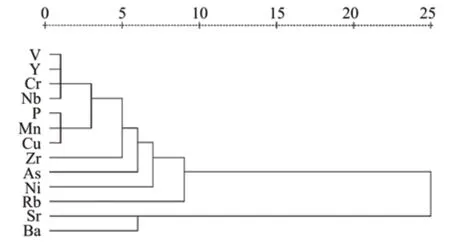
Figure 4 Cluster analysis of trace elements in the JJ profile,southeastern Mu Us Desert
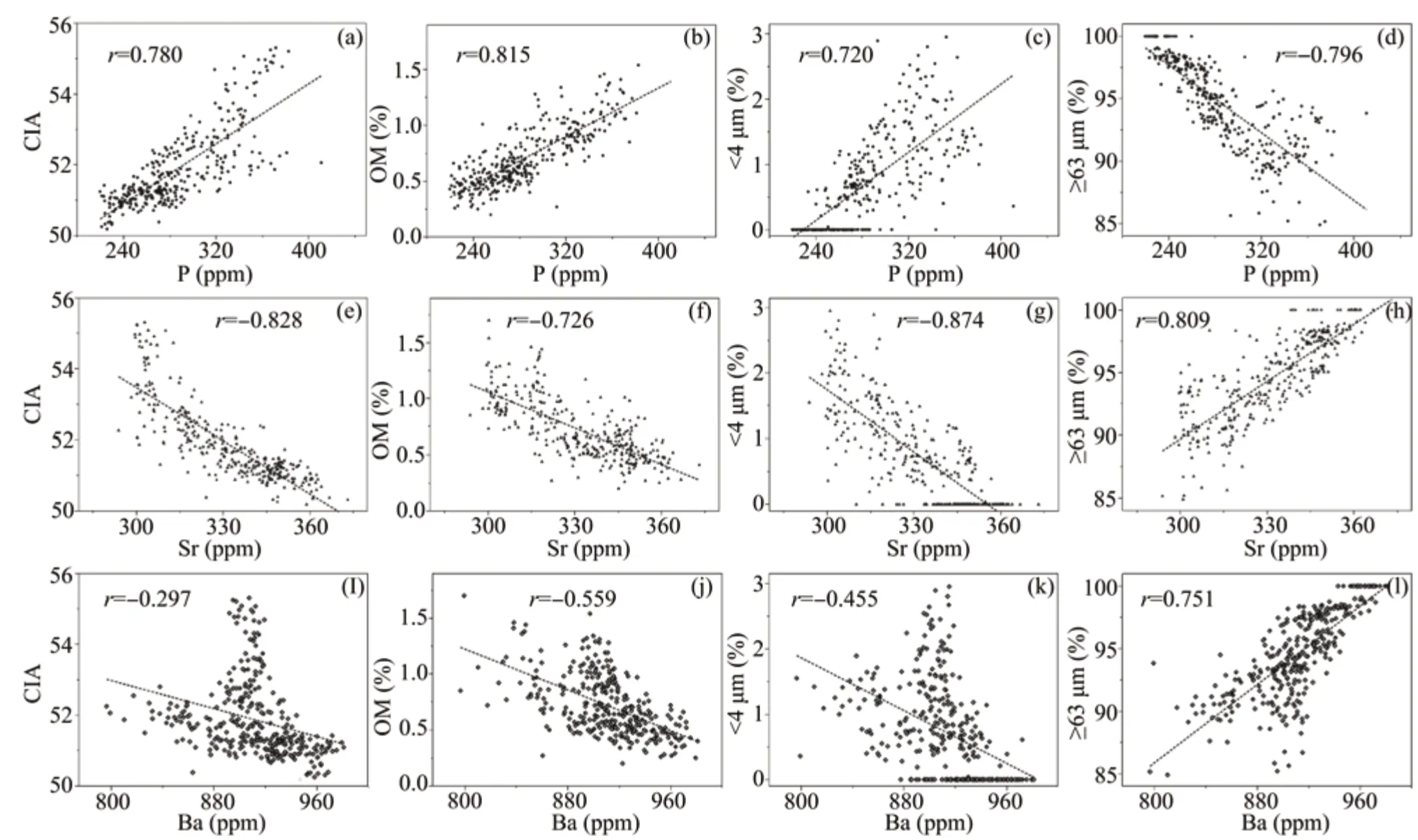
Figure 5 Relationships of trace elements with CIA,OM,<4-μm,and ≥63-μm content in the JJ profile
5 Discussion
5.1 Holocene millennial-scale climatic changes inferred from trace elements of Aeolian deposits
We reconstructed Holocene climatic changes in the southeastern Mu Us Desert based on variation of trace elements in different lithologies of the JJ profile,in combination with OSL and conventional14C dating ages(Figure 3):
(1)Before approximately 7.2 ka,the lithology was comprised of aeolian sand,with a lower P content and higher Sr content, implying weaker summer monsoons and a dry climate.At that time,the southeastern Mu Us Desert strongly expanded,as indicated by typical aeolian sand in the Jinjie profile prior to 7.50±0.37 ka (Ma et al., 2011), in the ZBT profile before 7.50±1.23 ka(Mason et al.,2009),in the Jinbian profile before 7.9 cal. ka B.P. (Zhou et al., 2002), in the Gaojiashan profile before 7.6-8.0 cal. ka B.P. (Chen et al.,1994), and in the Sandaogou profile before 7.9-8.5 cal. ka B.P. (Gao et al., 1993). In the desert interior,multi-proxy analyses indicated that cold and dry conditions dominated the region, leading to shallow lake levels(and even dry;Guo et al.,2007).In Daihai Lake,pollen data indicated that arid-type herbs and shrubs grew around the lake basin before 7.9 cal. ka B.P.(Xiao et al., 2004). Mason et al. (2009) discovered that dry conditions at the desert margin during that time can be explained by a dynamic link between enhanced diabatic heating in the core region of strengthened monsoons and increased subsidence in drylands to the north, combined with high evapotranspiration rates due to high summer temperatures.
(2)During the time interval of 7.2-4.6 ka,the strata consisted of grey and yellowish-brown and taupe palaeosol, and the P content reached the maxima while the Sr content was lowest in the profile,indicating abundant rainfall and the strongest Asian summer monsoons. Similarly, intense pedogenesis dominated the southeastern Mu Us Desert: the palaeosol was formed in the Jinjie profile in 7.5-3.9 ka (Ma et al.,2011), in the JJ and TYG profiles during 8.8-5.6 ka(Sun et al., 2006), in the DBY profile around 7.47 ka(Zhou et al., 2009), in the ZBT profile in 7.50-2.67 ka(Mason et al.,2009),and in the Sandaogou(Gao et al., 1993), Yuling (Zhou et al., 2002b), Luxi (Zhou and Zhang, 1992) and Gaojiashan profiles (Chen et al., 1994) in 8.4-4.5, 8.6-2.1, 5.2-4.9, and 7.3-3.4 cal.ka B.P.,respectively.In the desert interior,the palaeosols were also strongly developed; their ages are 7.7-4.9 cal. ka B.P. in the Taoli profile (Zhou and Zhang, 1992), around 7.72 ka in the BTW profile and 7.68-6.22 ka in the HK profile (Xu et al., 2013), and 8.54-4.93 ka in the Dalashi profile (Ma et al., 2011).The vegetation was dominated by woody grasslands and pine-oak mixed forest at Barhannur Lake in 7.13-4.21 ka B.P., implying a warm-humid and stable climatic optimum (Huang et al., 2009). Forest steppe and mixed broadleaf and conifer forests were formed around Qigainur Lake and Daihai Lake in 9.2-2.8 cal.ka B.P.and 7.9-4.45 cal.ka B.P.,which reflect generally humid circumstances (Xiao et al., 2004; Sun and Feng, 2013). In addition, temperate deciduous forests became the main component of the regional vegetation in eastern and middle Inner Mongolia during 7.0-3.0 cal.ka B.P. (Huang et al., 2004). However, details of the lower P content and higher Sr content in the JJ profile indicate two short-term dry events, around 7.0-6.8 ka and 6.6-5.7 ka, based on the profile chronology derived from the depositional rate analysis method.
(3)During the time interval of 4.6-3.5 ka,the sediments presented a cycle of two aeolian sands and one palaeosol. Compared to the previous stage, the P content rapidly became lower,while the Sr content presented higher content,marking declined summer monsoons and obviously dry conditions.At that time,massive aeolian sand accumulated in the southeastern Mu Us Desert; their ages are before 4.9, 3.54-2.93, and <3.7 ka(OSL dating) in the JJ (Sun et al., 2006), Jinjie (Li et al., 2007) and Dalashi profiles (Ma et al., 2011), and before 3.8-3.5,3.4-2.7,and 3.9-3.6 cal.ka B.P.in the Gaojiashan (Chen et al., 1993), Sandaogou (Gao et al.,1993)and Jingbian profiles(Zhou et al.,2002),respectively. In addition, a Pinus-grass forest steppe evolved from the Pinus-oak mixed forest in Bahannor in the desert interior since 4.2 cal. ka B.P. (Huang et al., 2009).However,further studies indicated that palaeosol developed in 4.1-3.7 ka in the JJ profile, accompanying the relatively high P content and lower Sr content, which probably recorded a transient wet period.
(4) During the time interval of 3.5-3.3 ka, the developed palaeosol was accompanied by increased P content, while the Sr content sharply decreased, denoting a gradually warmer and wetter environment with enhanced summer monsoonal strength. Analogously,several geological records demonstrated strong pedogenic environments and relatively warm and humid climates in 3.4-2.7, 4.2-3.6, 3.8-3.4, and 4.33-2.59 ka from the Sandaogou (Gao et al., 1993), Hejialiang,Gaojiashan (Chen et al., 1993, 1994) and Jingjie profiles (Li et al., 2007), respectively, in the southeastern Mu Us Desert.This phase was also coincident with the warm period in the Longshan Culture, Xia and Shang Dynasties, and the regional vegetation was dominated by typical steppe herbs and shrubs(Chen et al.,1994).
(5) During the time interval of 3.3-2.5 ka, the Sr content dramatically increased with the accumulated aeolian sand, whereas the P content decreased, marking a dry climate and declined summer monsoonal intensity. In general, this period can be divided into two substages: in 3.3-3.1 ka, the lithology was well-sorted aeolian sand, the P content was the lowest except for during 4.6-3.5 ka,and the Sr content was the highest in the profile; in 3.1-2.5 ka, the sand deposits had an aeolian progradation laminae with high Sr and lower P contents.These evidences are accordant with previous results that a relatively dry climate and intense desertification dominated the Mu Us Desert region during 3.0-2.7 ka(Chen et al.,1994).
(6) Around 2.5 ka, a weak palaeosol developed,and the P content showed a secondary peak (high content) while the Sr content became lower compared to the previous stage, demonstrating increasing monsoonal precipitation and relatively warm and humid conditions. Likewise, large-scale palaeosols formed in the southeastern Mu Us Desert; their ages are 2.93-1.74,2.59±0.15, 2.39±0.04, 2.3-1.9, and 2.5-2.1 ka in the Jinjie, YYC, Sandaogou profiles (Gao et al., 1993; Jin et al.,2001;Zhou et al.,2009;Ma et al.,2011),respectively.The Taobao profile also documented that aeolian sand deposits were replaced by palaeosols in the hinterland of the desert at that time(Chen et al.,1994).
5.2 Holocene aeolian activity and palaeosol development and their response to climatic change
The desert is the product of a dry climate, which is mainly controlled by effective moisture forced by regional climatic variation, especial in the Asian summer monsoonal boundary zone of northern China (Gao et al., 1993; Lu et al., 2005; Mason et al., 2009). In order to ascertain the relationship between aeolian activation and palaeosol development in the Mu Us Desert and regional dry-wet changes, we established the spatial-temporal variations (PDF, Probability Density Function,Figure 6) of the aeolian sand and palaeosol based on OSL dating, and conducted the contrastive analysis with the geochemical record of trace elements. The results indicate that stronger aeolian activity is mainly concentrated at 11.0-8.5, 4.5, 3.0 and 1.0 ka (Figure 6a), while the palaeosol was obviously developed around 9.0-6.5, 4.5-3.5, 2.5 and 1.0 ka (Figure 6b). In general,the intensive aeolian activity and scarce palaeosol development in the Early Holocene are apparently consistent with the dry climate condition evidenced by proxies before approximately 7.2 ka. In contrast, the massively developed palaeosol and declined aeolian surroundings are accordant with the relatively wet climate in the Mid-Holocene especially during 7.2-4.6 ka.Afterwards,aeolian activity again dominated the regional environment,which is accompanied with the regional arid climate and declined palaeosol development (Figures 3 and 6).On the Holocene millennial-scale,the intervals of enhanced aeolian activity around 4.5 ka and 3.0 ka correspond to the dry substages of 4.6-4.1 and 3.3-2.5 ka, which are also together with decreased P and increased Sr contents. In contrast, the intervals of enhanced palaeosol development are coincident with high P and lower Sr contents of the profile during the middle and Late Holocene(around 4.1-3.7 and 2.5 ka).Accordingly, we preliminary concluded that the regional desert environmental variations are the result of climate dry-wet fluctuations in general.
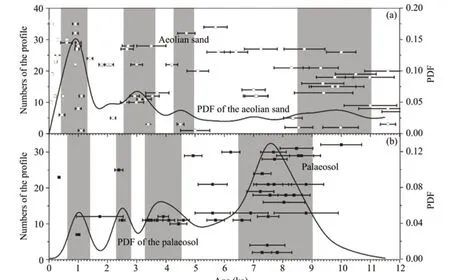
Figure 6 Holocene aeolian activity and palaeosol development in the Mu Us Desert,the OSL ages were collected from published literatures and this study(Lu et al.,2005,2013;Sun et al.,2006;Li et al.,2007;Zhou et al.,2009;Ma et al.,2011;Jia et al.,2015;Zhao et al.,2016)
5.3 Possible linkage of millennial-scale dry events in northern China and global change
Asian summer monsoonal strength is mainly controlled by the thermal differences between the Asian continent and the tropical Pacific Ocean (An, 2000),which is closely related to solar radiation variation in the orbital and sub-orbital scale (Wang et al., 2005,2008).In the Asian monsoonal boundary zone,northern China, regional precipitation is mainly influenced by Asian summer monsoonal strength (Jin et al., 2001; Lu et al.,2005;Mason et al.,2009;Liu et al.,2014b;Chen et al., 2015). We therefore compared our results with different archives from the low, middle and high latitudes of the Northern Hemisphere and external drive(Solar total radiation, TSI) to discuss the Holocene Asian summer monsoonal change and millennial-scale dry events in northern China and global change (Figure 7).These results indicated that the weak intervals of the Asian summer monsoonal intensity (Figure 7c) is very accordant with lower sea surface temperature in the western tropical Pacif ic Ocean and declined TSI around 7.6-7.2,6.9,6.5-6.1,5.7-5.2,4.6-4.2,3.7-3.2 and 2.8-2.5 ka in the low latitude of the Northern Hemisphere(Figures 6a,6b). In the middle latitude, similar records were discovered in aeolian deposits and lake sediments,i.e., the probability density distribution of the Holocene palaeosol dating in the Loess Plateau (Figure 7d, Wang et al.,2014)suggests that the density value remains high from 8.8 to 3.4 ka, indicating increased Asian summer monsoonal strength in the Mid-Holocene. However, the 6 lower density values emerge during that time, which demonstrated declined summer monsoon and deteriorative climatic conditions. In the northern Mu Us Desert,Sun and Feng (2013) also discovered that a series of transiently lower precipitation intervals are accompanied with the whole pattern of regional climate change from Qigainor Lake, especial in 7.4-6.0 and 4.0-2.8 ka(Figure 7e).In Daihai Lake,Xu et al.(2003)found that four intervals (7.6-7.4, 5.1-4.8, 4.45-3.9 and 3.5-2.9 ka) of declined temperature and rainfall were superimposed on the general Holocene climatic change tendency based on the pollen-climate transition function (Figure 6f). Additionally, recent results (Chen et al., 2015)from a closed Gonghai Lake near the Asian summer monsoonal boundary, indicated a Mid-Holocene optimum climate period around 7.8-5.3 ka, nevertheless,there are still several lower rainfall episodes in that time, such as, 7.4, 6.3, 4.5, 3.4 and 2.7 ka (Figure 7g).In the southeastern Mu Us Desert,our palaeoclimatic reconstruction derived from the JJ profile indicates that Holocene climate changes were interrupted by six millennial-scale dry events and their ages are around approximately 7.2,7.0-6.8,6.6-5.7,4.6-4.1,3.7-3.5,and 3.3-2.5 ka (Figures 7h and 7i). Obviously, these results are preferable corresponding to the record of trace elements from the JJ profile on the Holocene millennialscale framework.In the high latitude of the North Hemisphere, the 1,500-year period of the IRD (Ice Rafting Debris) events from the North Atlantic Ocean (Figure 7j;Bond et al.,2001)is in accordant with the aforementioned records in the low and middle latitudes of the Northern Hemisphere.The GISP2 potassium ion is usually regarded as an index of the winter monsoon and related temperature variation in the past environmental study (Mayewski et al., 1997), the comparative analysis demonstrated that the weak summer monsoonal intervals of our records are contemporaneous with increased potassium ion concentration in the GISP2,e.g.,7.5-7.2,5.8-5.3,4.5-4.2,and 3.0-2.6 ka(Figure 7k).
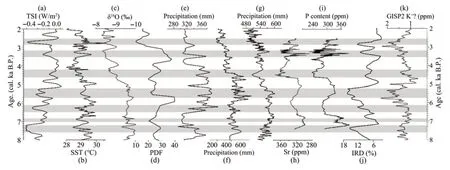
Figure 7 Comparison of Holocene millennial-scale dry events between Mu Us Desert and different archives from the low,middle,and high latitudes of the Northern Hemisphere.(a)Solar total radiation(TSI,Steinhilber et al.,2012);(b)Temperature change in the western tropical Pacif ic Ocean in the Holocene epoch(Stott et al.,2004);(c)Variation of the Asian Summer monsoonal strength from center China(Hu et al.,2008);(d)Probability density distribution of the Holocene palaeosol in Loess Plateau(Wang et al.,2014);(e)Precipitation change in Qigainor Lake(Sun and Feng,2013);(f)Precipitation change in Daihai Lake(Xu et al.,2003);(g)Precipitation change in Gonghai Lake(Chen et al.,2015);(h)Variation of the P content in the JJ profile(this study),its increased content denoted enhanced Asian summer monsoonal strength;(i)Variation of the Sr content in the JJ profile(this study),its decreased content marked declined summer monsoonal intensity and relatively dry circumstances;(j)Ice rafting debris(IRD)events of the North Atlantic Ocean(Bond et al.,2001);(k)K+concentration in the GISP2(Mayewski et al.,1997)
The aforementioned evidence demonstrates that signals of Holocene millennial-scale climatic change(cold intervals, dry events, and weaker summer monsoonal periods) were coincident with the stalagmite evidence in low latitudes (Hu et al., 2008), aeolian sand and lake deposits in the middle latitudes, and in deep-sea and ice core deposits in high latitudes of the Northern Hemisphere, although there were some differences in years, times, and durations in different regions. This study provides detailed evidence for the prominent synchronism between climatic change in a regional and global scale.
6 Conclusions
We reconstructed Holocene millennial-scale climatic changes based on analysis of the variation of trace elements in different lithological units of the palaeosol-aeolian sand deposits in the JJ profile, southeastern Mu Us Desert, China. Our main conclusions are as follows:
(1) The contents of 11 trace elements, represented by higher P and lower Sr content in the palaeosols,indicate a relatively humid climate, along with increased Asian summer monsoonal strength, weathering degree, and ameliorative vegetation. Conversely,the lower P content and higher Sr content in aeolian sand reflect dry conditions, accompanying weaker summer monsoons, degraded vegetation, and less weathering.
(2) Holocene climatic changes in the southeastern Mu Us Desert can be divided as follows:relatively arid conditions dominated the region before 7.2 ka, followed by an optimal warm and humid climate in 7.2-4.6 ka. In 4.6-3.5 ka, the climate became dry on the whole, although there was a secondary wet interval in 4.1-3.7 ka.The climate tended to be relatively humid in 3.5-3.3 ka,and became obviously dry in 3.3-2.5 ka with frequent fluctuations.Afterwards,a relatively humid climate emerged again.
(3) Comparison studies indicate that six millennial-scale dry events were superimposed on the whole Holocene climatic change tendency, and they also were contemporaneous with weaker Asian summer monsoonal intervals and periodic cold events in the low and high latitudes of the Northern Hemisphere,which indicate a noteworthy synchronism between millennial-scale climatic changes in this region and on a global scale.
Acknowledgments:
This research was funded by the National Natural Science Foundation of China (Grant Nos. 41501220,41671204), China Postdoctoral Science Foundation(Grant Nos. 2015M570861; 2017T100783), Natural Science Foundation of Gansu Province, China(1506RJZA287) and Key Laboratory of Desert and Desertification, Cold and Arid Regions Environmental and Engineering Research Institute, CAS (KLDD-2017-002).
 Sciences in Cold and Arid Regions2019年2期
Sciences in Cold and Arid Regions2019年2期
- Sciences in Cold and Arid Regions的其它文章
- Effects of freeze-thaw cycle and dry-wet alternation on slope stability
- Analysis of vegetation changes and dominant factors on the Qinghai-Tibet Plateau,China
- Shifts in community structure and function of ammoniaoxidizing archaea in biological soil crusts along a revegetation chronosequence in the Tengger Desert
- The establishment and development of Haloxylon ammodendron promotes salt accumulation in surface soil of arid sandy land
- Editors-in-Chief Guodong Cheng and Ximing Cai
- Review on simulation of land-surface processes on the Tibetan Plateau
